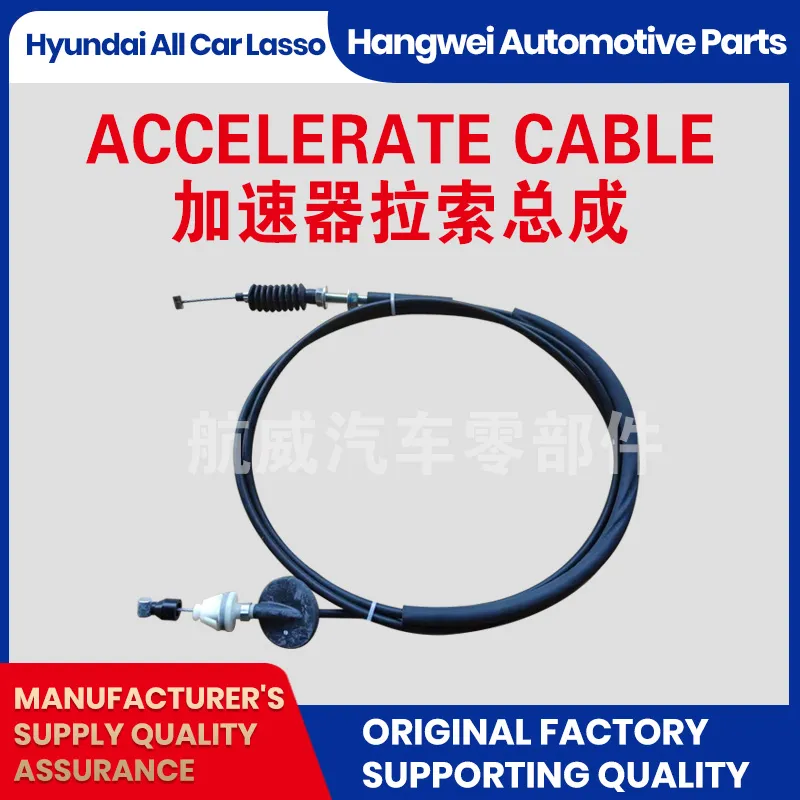Need a Durable, Universal Throttle Cable for Any Engine?
Accelerator Push-Pull Cable: real-world engineering, not just catalog talk
If you’ve ever pressed a pedal and expected instant response, you’ve relied on a throttle cable that quietly does its job. This Accelerator Push-Pull Cable comes from Qinghe County Minjiang Street south, Wuzhishan Road east, and, to be honest, it’s the sort of component most drivers never think about—until it isn’t smooth. In fact, the assembly transmits pedal input to the engine control system with low-friction consistency. I’ve toured workshops where these are built: lots of swaging presses, coil winders, and a surprising amount of hand-feel testing by technicians who can spot a rough jacket by touch.

What’s inside and why it matters
The cable core is typically stainless (SUS304 or similar) for corrosion resistance; the conduit uses a steel spiral with a PTFE-lined HDPE or PA6 inner tube. End fittings are crimped or die-cast zinc. Methods: multi-stage swaging for terminal pull strength, controlled heat treatment for wire memory, and jacket extrusion for abrasion resistance. Testing? Salt spray (ASTM B117/ISO 9227), cycle life rigs at elevated temps, tensile pull to verify safety factors. Real-world use may vary, but the data below is solid.
Product specs (typical)
| Parameter | Specification (≈) |
|---|---|
| Inner wire | SUS304, 7×7 strand, Ø1.2–2.5 mm |
| Conduit | Steel spiral, PTFE-lined HDPE/PA6 |
| Operating temp | −40 to 120 °C (short peaks 150 °C) |
| Min. bend radius | ≥ 75 mm (application dependent) |
| Friction coefficient | ≤ 0.08 in new state; ≤ 0.10 after aging |
| Cycle life | ≥ 300,000 actuations @ 80 °C, 50 N load |
| Corrosion | ≥ 96 h neutral salt spray with no red rust |
| Certifications | IATF 16949, ISO 9001, RoHS |
Where it’s used
Passenger cars, light trucks, buses, motorcycles, marine engines, gensets, agricultural equipment, and even construction machines. Many customers say the throttle cable feels “lighter” after switching to a PTFE liner. I guess that’s the hidden value—operator comfort turns into control precision.
Trend watch
Drive-by-wire keeps growing, but the throttle cable isn’t going away in harsh-duty and cost-sensitive platforms. Two big shifts: corrosion-proof materials for marine/snowbelt use and tighter bend-capable conduits for compact engine bays. Customization is the competitive moat now.
Process flow at a glance
Material incoming QC → wire stranding → conduit winding → liner extrusion → end-fitting swage/crimp → dimensional check (stroke, free play) → friction/drag test → salt spray aging → 100% functional pedal-to-ECU stroke verification → packing. Service life targets are validated by endurance rigs and random lot verification. It sounds dry, but those checks are why a throttle cable feels consistent at 200,000 km.
Vendor snapshot (indicative)
| Vendor | Certs | Lead Time | Customization | Notes |
|---|---|---|---|---|
| HWEI (Qinghe) | IATF 16949, ISO 9001, RoHS | 2–4 weeks | Stroke, fittings, jacket, labeling | Strong OEM/QC discipline |
| Cablecraft / Orscheln | IATF 16949, ISO 9001 | 3–6 weeks | Broad catalog + custom | Global support network |
| Lokar (aftermarket) | ISO 9001 (varies) | Stock/short | Hot-rod fitment kits | Great for custom builds |
| Generic import | Varies | 1–5 weeks | Limited | Check test data carefully |
Customization and feedback
Options include jacket color, end fittings (M5/M6 threaded, clevis, ball), stroke length, bend-tolerant conduit, and labeling for traceability. A fleet manager told me their throttle cable replacements dropped 28% after switching to stainless cores and longer radii routing. Another buyer liked the “noticeably smoother cold-start pulls.”
Quick case notes
- Marine OEM: upgraded to SUS304 core + sealed boots; passed 240 h salt spray; warranty claims near zero in one season. - City bus refit: PTFE liner reduced pedal effort ~15% and improved idle control variance on dyno by 0.2% (nice win).
Compliance and standards
Built under IATF 16949/ISO 9001 QMS, materials screened for RoHS; corrosion tested to ASTM B117 or ISO 9227; design aligned with industry practices for accelerator controls (see SAE references). That’s the backbone behind a dependable throttle cable.
References
-
Clutch Line: Braided, Leak-Proof, OEM-Grade PerformanceNewsNov.10,2025
-
Throttle Cable: Durable, Smooth Control & Universal FitNewsNov.10,2025
-
Throttle Cable: Durable, Smooth, Universal Fit, Easy InstallNewsNov.10,2025
-
Clutch Line: Durable, Leak-Proof, OEM-Grade PerformanceNewsNov.10,2025
-
Hand Brake Cable | Custom, Universal & Trailer SolutionsNewsNov.10,2025
-
Clutch Line: High-Pressure, OEM-Fit, Corrosion-ResistantNewsNov.03,2025
